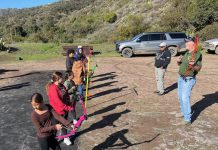Editor’s Note: Jim Watson is the author of “Mysterious Island: Catalina,” available at Amazon, Kindle and in stores in Avalon.
Editor’s Note: Jim Watson is the author of “Mysterious Island: Catalina,” available at Amazon, Kindle and in stores in Avalon.
“Natural Hazard.”
That seems to be the preferred terminology by environmental scientists and the federal government for any sort of potential natural disaster that might befall any particular locale.
Such a term as used by entities like National Oceanic and Atmospheric Administration, the U.S. Geological Survey and NASA, encompass a wide variety of would-be disasters, including hurricanes, tornadoes and earthquakes along with such non-violent offenders as drought and frost.
Catalina Island is blessedly free of much of this unwanted attention from nature. Eastern Pacific hurricanes always seem to peter out before coming this far north; the big quakes that strike the L.A. area every decade or three tend to be weary temblors by the time they reach us; and the not-infrequent winter waterspouts tend to stay offshore like good little waterspouts should.
Sure, we have the occasional grass fire and nor’easter. And low-rainfall tends to be a proverbial and perennial monkey on our backs. But all in all we live a generally calamity-free existence out here.
So it is with some irony that some of the most visible examples of nature’s fury have come to us from events borne thousands of miles away, namely the tsunami. And even then, due to its undersea topography and funnel shape, Catalina Harbor up at the Isthmus is really the only place on the Island that feels such events.
The recent tsunami that devastated northern Japan was the latest example. A quick search on YouTube will yield a video clip or two taken aboard vessels in Cat Harbor being swiveled and swirled about as the harbor dramatically loses—and then regains—its water.
A number of small boats actually capsized in this event.
Former Avalon Mayor Rudy Piltch remembered the effects of the 1964 tsunami created by the massive 9.2 magnitude Good Friday Earthquake in Alaska. He had been alerted by Doug Bombard, then-head of operations at the Isthmus, that the Coast Guard had issued a tsunami warning.
“Another fellow and myself took a boat and went out into Cat Harbor because we had a number of visitors on their boats on moorings,” said Rudy. “We let them know the information the Coast Guard had conveyed.”
That information was for all boaters to get out of Cat Harbor and into deeper water where the effects of a tsunami would be minimal.
It was when Rudy was towing a float out of the harbor when the first wave hit.
“Just as we got opposite Ballast Point was when the first big swell came in,” he said. The swell carried them nearly from the mouth of the harbor back to the little pier in Cat Harbor where they had started, a distance of about 200 yards.
Rudy noted that it wasn’t so much a violent wave as it was a dramatic rise and fall in sea level.
“The tide gauge showed an 8-foot tidal change in about five or six minutes of time,” he said.
The wave quickly sucked back out again into the open ocean, temporarily leaving a number of mooring balls high and dry in the upper reaches of the harbor.
A similar event occurred at Cat Harbor in 1957 several hours after an 8.6 quake stuck in the far reaches of the Aleutian Islands.
Chuck Liddell’s father was an eyewitness to the event and passed the story down to his son.
Orville Liddell was chief engineer for the Wrigleys in those days and found himself on this particular day headed to the West End.
“Dad was going to the Isthmus to do some surveying,” said Chuck. “He was standing facing the opening to Cat Harbor.”
After taking a sighting through his surveying equipment, the senior Liddell had turned to his notebook to make some calculations. He looked back into the eyepiece and noticed the horizon had ‘gone up’,” said Chuck.
“Thinking he had hit the eyepiece, he chuckled to himself and readjusted his equipment.”
But then it happened again. After taking another sighting and looking away for a moment, Orville noticed the horizon had “moved” again. As Orville stood there scratching his head, he looked at the harbor and watched as “suddenly a wall of water came up.”
Chuck said his father watched in amazement as the water rushed up nearly to the old Civil War barracks. It stopped at the last second and then “went out and stripped everything out of the harbor,” said Chuck.
An article from the March 14, 1957, Catalina Islander reported that the water “surged in through the narrow inlet and then swirled out again like a rushing river. Boats at anchor in the normally sheltered bay were tossed around like corks.” Of special concern were the famed glass-bottom boats Phoenix and the Blanche W., both of which were both moored at Cat Harbor at the time and were saved only by the “heroic efforts of crews and volunteers,” said the article.
There have no doubt been other visitations to Catalina by tsunamis over the years. Many probably occurred in prehistoric times and others may have simply not been noticed or were perhaps not identified as tsunamis because of the technology of the times.
And, too, there will no doubt be such visitations in the future.










